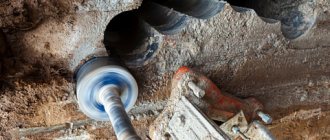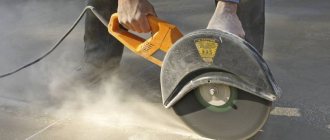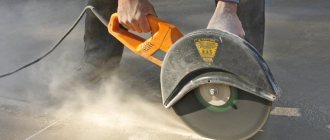For cutting massive, capital structures made of reinforced concrete, in cases where the use of wall cutting machines is impossible, the technology of diamond cutting with rope is used. This method allows you to obtain an accurate cut, even when working with very durable materials or substrates over 1 meter thick. The cutting rope is a cable with inserts made of diamond-coated elements. Dragging the rope along the cutting line allows you to get an even and finished cut. If more delicate work is required, we can offer cutting with a diamond wire, which allows us to achieve jewelry precision during dismantling.
Diamond wire rope cutting technology
For diamond cutting with rope, ropes of various thicknesses are selected, taking into account the strength of the material being cut and the level of accuracy of the work performed. The rope cutting procedure is carried out in several stages:
- On the surface to be cut, the outline of an opening or a cut of a different shape is outlined;
- At the corners and joints of the marked figure, through holes are drilled with diamond bits, allowing the desired cutting shape to be obtained when connecting the contour;
- Insert the rope into the holes drilled with a diamond core so that the marking line coincides with the cutting line;
- The tension force of the rope is adjusted, the cutting system is started, regulating the tension force of the rope, allowing for uniform wear of the equipment.
Rope cutting is used not only for walls, but also for free-standing structures such as columns, pillars, etc. When cutting columns or supports, a cable is encircled around the surface at the level where the cut is supposed to be made.
Features of the method
To experience all the benefits of wire sawing. Strict adherence to technology is required. For different types of materials, the speed of rotation of the cable is different, the lower the speed, the faster the rope wears out; if the speed is higher than that required for a given rock, the rope can become “soiled,” and in order to start working with this cable again, it must be re-opened, losing a lot of time. and rope resource.
The rope must be twisted.
Often our clients neglect curling or do not take it seriously. But the correct wear of the cable depends on the correct twisting, because if the cable is not worn evenly, you will also lose money later, because the rope will not exhaust its resource to the end.
Insufficient pressure
Often our clients, in order to achieve an increase in the life of the diamond wire, deliberately lower the productivity, but for proper opening of the rope, pressure is necessary. Therefore, at this point you should strictly follow the instructions.
Application area of diamond wire cutting
Due to the complexity and high productivity of wire diamond cutting technology, it is worth using this method when dismantling large objects or high-strength structures. In particular, wire cutting is used in the following cases:
- Dismantling of columns, supporting structures with a diameter of 2 meters or more;
- Cutting walls with a thickness of 1 meter and a cut length of 2 meters or more;
- Cutting using the immersion method, in the absence of access to the surface being processed on both sides;
- Cutting foundations of increased thickness;
- Cutting structures with double or reinforced reinforcement belts and the use of reinforcement with a thickness of 1 cm.
Thus, rope cutting is an effective solution to the problems of dismantling capital structures, which otherwise can only be demolished using a controlled detonation method.
Why concrete needs to be cut
Everyone knows the strength of concrete and the strength of structures made from it. Modern technologies make it possible to pour concrete frames for high-rise buildings, and very modern technologies make it possible to print houses on a printer.
However, despite the strength of concrete, it does not withstand impact loads well, especially with special impact tools. Direct impacts on the concrete surface are especially dangerous for the integrity of concrete structures. It is for this reason that in houses made of monolithic concrete and panel houses made of concrete slabs, punching holes and making furrows with hammer drills is not recommended.
On the other hand, concrete can be cut and this rule is used to prepare for engineering work.
Advantages of diamond wire cutting
- There are no dynamic shock or vibration loads, cutting is carried out without destroying nearby structures;
- Low level of noise and dust, the ability to operate in conditions requiring the absence of sparks or dust in the object;
- Possibility of cutting structures partially or completely under water;
- High performance compared to other technologies.
If you are interested in wire cutting services, our company is ready to offer professional solutions and affordable prices.
The minimum cost of traveling around Moscow for rope cutting work is 25,000 rubles
Quarry rope
Recommended cutting speed
- Granite 1 - 2: 25 - 30 m/s
- Granite 3 – 4: 22 – 26 m/s
- Granite 5: 20 - 22 m/s
- Marble: 30 - 35 m/s
Wire saw
- — power minimum: 50 hp
- — linear speed of the rope: 20-30 m/s, V=(3.14*N*Ø)/60 sec, where N is the number of wheel revolutions, Ø is the wheel diameter
- — feed speed: 0.4-0.5 m/h
- — load control parameter: constant reading on the ammeter
How to work?
- — rope tension: constant adjustment based on ammeter readings
- - do not overtighten
- — the tension at the output should be sufficient, the tension at the input should be free, at the start the rope should have a slight slack in case of an increase in the controlled parameter (main motor ammeter)
- - first step: increase water supply
- — second step: reduce the reverse speed. Normal speed is in the range of 40-50 cm/h, low speed is considered less than 40 cm/impact on rope speed
- — in case of high speed, segments may become blurred - you need to reduce the speed
- - in case of low speed, the segments will wear out quickly when cutting on a rainy (wet) day.
- - cover the outer part of the stone on top with plastic film to prevent water from entering holes, holes, cracks
- — the segments can bunch up and the rope can easily get stuck.
How to work with a 50-meter rope?
Cut 10 m from the main loop after 8-10 hours of work (the shorter, the more twist). Replace bushings after 4-5 hours of operation. When connecting, press twice, turning 90°. Inspect the connecting sleeves every 20-30 minutes, change if necessary; quickly finish at the end of cutting (do not use a new rope at the finish); cautions before starting cutting:
- - round the edges
- - inspect the tires on the wheel
- — maximize the radii of rope bends
- — 50 m in operation: 1.5 rpm
- — 40 m in operation: 1.6 rpm
- — 30 m in operation: 1.8 rpm
- — finish: 2 rpm
Procedure for using water when cutting.
- — It is normal to use 3–5 water entry points.
- — The position and quantity should change during the work process.
- — The performance and cutting parameters largely depend on the amount of water.
Problems encountered during the cutting process
A problem that occurs when there is a lack of water.
Incorrectly used rope. This happens when working in forced mode, when the rope is not cooled enough (overheating). As a result, due to the fact that the liquid was supplied at two points, the elastic bands were wiped out and the segments gathered.
Reason for assembling the segments together.
- — Segments are collected at the exit due to stone chipping, they need to be wedged well
- — At the start, due to the fact that the edges are not filed and are quite sharp
- — Using a new rope at the finish (more rigid)
- — Interruptions or stoppage of water supply during operation.
Wear with irregular “V” geometry.
- — Delivery is very fast
- — Lack of water
- — The increase in speed led to the rope rubbing on one side. The ends of the segments are broken
Prices for cutting with diamond wire
| Material | Price for 1m2 (rub) |
| Reinforced concrete | 12950 |
| Concrete | 12025 |
| Brick | 11100 |
The price for cutting with a diamond wire is given per 1 m2 of cut (length of cut * depth of cut)
- When calculating the cost of work, it is necessary to take into account the conditions in which the work is carried out.
- The cost of a minimum visit within the Moscow Ring Road (for work with hand cutters is 7,000 rubles). — (for work with wall cutting machines and joint cutters — 22,000 rubles)
- For an accurate calculation of the cost of work, call;
- Discounts are available for large volumes!
Sawing process
Before starting cutting with a new rope, you need to cut for the first hour or two at a lower speed of 4 m/sec from the recommended one. This will ensure that the diamond wire opens properly, removes any plastic residue and ensures work in the best conditions. Before starting sawing with a previously used rope, you must check:
- - average diameter of bushings;
- - eccentricity (maximum deviation - 0.3 mm);
- — taper (maximum deviation — 0.3 mm);
- - condition of the rope connection, integrity and working condition of the bushings; (absence of cavities, opening of diamonds
When passivating a block
Sawing on slabs can be carried out at fairly high speeds. In this case, cutting without lower guide pulleys located at the entrance and exit of the block is allowed, since they are used primarily to guide the supply of the rope when entering the cut, as well as to weaken the vibration of the rope.
When sawing slabs for further polishing, high cutting accuracy and surface smoothness are required. To do this, the cutting speed must be reduced to prevent deviations at the beginning and during the cutting (in general, the cutting speed should be 15-20% lower than that used for passivation of blocks into slabs). When cutting short blocks, guide pulleys are used at the entry and exit of the block and a check is made to ensure there is no side play.
When the rope enters the block, it is recommended to avoid working in automatic mode; the feed speed should be reduced by 20-30% of the recommended one. When cutting in automatic mode, the feed speed of the flywheels is controlled through the current in amperes. When the load increases, the feed automatically decreases, and when the load decreases, it increases. In the absence of an automatic adjustment system, it is necessary to visually monitor the load readings (in amperes) and adjust the rope feeding parameters manually.
Stationary wire saws
Dimensions of processed material
depend on the distance between the drive wheels. There is no need to cut along the cut marks left by previous cuts on the surface of the stone, as a result, it is difficult to run the rope. Depends on whether we use satellites or not.
Cutting speed.
The harder the stone, the slower the cutting speed should be. In the case of high speed, the segments are washed out (salted) and the diamonds are damaged. At low speeds, the segments wear out faster. A speed of 20-35 m/s is considered normal, 29 m/s is recommended and 27 m/s for CNC machines.
Twisting.
A properly twisted rope makes one full revolution around its axis while moving between the wheels.
Cooling.
When starting cutting, it is necessary to provide water supply at the rate of 20-30 l/min at least at three points (sawing points). Excessive moisture impairs cutting performance; lack of water leads to rapid wear of the segments and the rope as a whole. After starting and reaching the nominal cutting mode, it is necessary to ensure the supply of water at the entrance of the rope into the stone, the remaining 2 - 3 points should be located along the cut. Move them as needed.
Stretch:
250 – 400 kg for cable Ø5 mm and segments Ø 10 – 11 mm 160 – 180 kg for cable Ø4 mm and segments Ø 8 mm
Cutting.
When using a new rope, cut at low speed for 1 - 2 hours. This is necessary so that the segments open up and expose the cutting diamonds. When processing small stones, satellites must be used to reduce rope vibrations. Try to keep the rope entry angle in the vertical plane in the range of 7 - 9° from the horizontal.
Machine installation.
Install the guide parallel to the location of the prepared holes so that the wheel is on the same axis with the holes. Install the second and subsequent guides in the same plane. The distance between the guide and the line of holes should be 15 - 20 cm. This is necessary to ensure a straight and even cut.
Adjustment.
Monitor the lateral displacement of the wheels and their tilt (they must be on the same axis and vertical).
Preparing the rope.
Add 10 m to the cutting perimeter to obtain the required rope length. The required rope length is determined when the main one is at the beginning of the guide mechanism. The greater the rope coverage of the wheel, the better the result. After drilling, rinse the holes with water. First insert a wire or rope into the holes, then, attaching a rope to it, wind it. Observe the direction of movement of the rope indicated on it. Pull out the wire (rope) so that both ends of the rope are at the beginning of the guide, and the rope is in the holes. Measure the required length of the rope , throwing the long end over the wheel and cutting it off. Remove excess rope from the working area
Rope connection.
Place the connecting sleeve on the end of the cable and press it in using a special tool, leaving a gap of about 1 mm between the sleeve and the segment. Before connecting into a loop, the rope must be twisted counterclockwise so that it can make a full revolution around its axis during the cutting process. The number of turns increases as the rope is shortened during operation, and amounts to 1.5 - 2 turns per meter, thereby the segment wears evenly over the entire surface and it is possible to avoid ovality in wear. After twisting, insert the second end of the cable into the connecting sleeve and press it in 2 times with a rotation of 90°. Turn the rope manually, thereby rounding the corners and rubbing the rope. Then throw the rope over the wheel and rotate it manually along with the wheel. Try to determine the number of revolutions of the rope. At three meters it should make from 0.5 to 1.5 revolutions around its axis, optimally 1. Stretch the rope and position the water supply points. The rope is ready for use.
Location.
Do not cover the surface to be treated or impede the progress of the rope. This is necessary to ensure free rotation of the rope and avoid oval wear. The saw should be located approximately 4 m from the surface to be processed. These actions are important to increase the lifespan of segments.
Before the start.
Round the corners. Check that the rope moves freely and that nothing is blocking its progress. Check the water supply, there should be enough (not too much, not a lot). Check the rubber ring on the wheel; it should be undamaged. Check the connection points of the rope, replace if necessary, make sure that the rope is without visible damage or bends.
Rope connection.
Do not mix rope of different types or sizes. This will lead to frequent ruptures and rapid wear.
Block size.
Do not use the rope to cut very large or very small blocks. In this case, the large bending radius prevents the free rotation of the rope, resulting in oval wear. It is necessary to tilt the block to reduce the bending radius of the rope
Rope tension.
Do not overtighten the rope while cutting.
Actions during work.
The rope works optimally at a feed speed of 20 – 35 m/s. Increasing the speed leads to blurring of segments and tearing out diamonds. Reduced speed leads to increased wear and the appearance of taper. Do not start cutting at high speed and pressure. Avoid large jumps in cutting conditions that could damage the wire saw.
End of cutting.
Use old rope for sharp exit angles when the rope bends too much.
Application of a slot milling machine
Slitter mill.
This tool is used to cut concrete inside small rooms where it is impossible to use devices with higher power. The slot freezer is a type of hand tool. Thanks to such a device, it became possible to easily saw concrete building structures with a super-strong, curved, complex surface.
Typically, a slot milling machine for cutting concrete composite is used inside apartments and other residential premises. This device operates in two modes: wet, dry. The second option is used for very deep cutting of concrete material. In this case, the water, which acts as a coolant, is removed using an industrial vacuum cleaner. The dry type of operation of the slot milling machine is harmless, non-hazardous, labor-intensive, with virtually no waste or dust.
Return to contents
Advantages
There are many positive qualities in cutting concrete with diamond devices:
- precise section frames;
- thanks to the even, smooth cut, there is no need to additionally process or polish the concrete;
- the process of cutting concrete occurs without unnecessary noise or vibrations;
- diamond cutting of concrete is accompanied by a small dust emission, and if water is used during the procedure, the appearance of dust is practically eliminated;
- Diamond cutting of reinforced concrete saves you money. After all, the procedure is quite simple, although it requires some skills. If there are any, anyone can do it without spending money on the help of experts.
The essence of diamond cutting of reinforced concrete structures lies in the use of certain mechanical devices with a cutting tip coated with diamond or a saw with diamond edges.
Even a familiar grinder with a diamond blade will make a quality cut in concrete. Moreover, the cutting element in contact with concrete is not erased, as when cutting metal structures.
The only disadvantage of this device is that it is possible to cut the composite only as deep as the size of the saw on the grinder allows.
Return to contents
Possible problems when using rope tools and methods for eliminating them
1. The rope “does not cut” (grinding diamond bushings)
This circumstance may be due to the discrepancy between the selected cutting modes and the recommended ones (too high linear speed of the rope, incorrect selection of tools, launching a new rope on hard granite with a high quartz content, high flow of coolant). To fix it, you need to open the diamond wire using one of the following methods:
Reduce the linear speed of the rope by 4 m/s for a while. At a lower peripheral speed, the rope cuts faster, which leads to increased wear on the bushings and exposure of the diamond grains. After opening the bushings, you must return to the recommended cutting parameters.
Make several cuts on abrasive material (sandstone, concrete, etc.). Reduce the amount of coolant (taking into account the risk of overheating and destruction of the rope).
2. Rope break
If the rope breaks “accidentally” (foreign objects getting into the cut, etc.), it is necessary to repair the rope (remove the damaged section and reconnect the rope).
If the rope breaks several times for an unknown reason, the tensioning system must be checked (the machine mechanisms must be checked by a technician). If the machine is in good condition, the rope must be replaced. After 100 m of cutting, rope breaks may occur as the supporting cable wears out.
3. Large cutting deviations
If the cutting is not accurate under normal operating conditions, it is necessary to reduce the feed speed by one or two cuts. It is also recommended to temporarily reduce the peripheral speed by 2-3 m/sec.
4. Large deviations at the beginning of cutting the block
The surface of the block is predominantly uneven in shape, so at the beginning of the cut the number of points of contact with the rope is limited. In this case, it is necessary to reduce the bottom feed speed by 20-30% of the recommended values until the rope completely enters the block being processed.
5. Conical wear of diamond bushings.
The consequence of such wear may be:
- — Linear cutting speed is too low. Accordingly, it is necessary to adjust the cutting speed in accordance with the recommended modes.
- — Incorrect selection of tools for the material being processed. In this case, it is necessary to replace the rope.
6. Ovalization of diamond bushings
If the ovalization of diamond bushings occurs on a short section of the rope, it is necessary to cut out this section, re-twist the entire length of the rope around its axis (at the rate of 1.5 turns/linear meter) and check the rotation of the rope after connecting it. If the diamond wire does not rotate around its axis, this indicates that it is worn out; accordingly, the rope must be replaced with another one.











